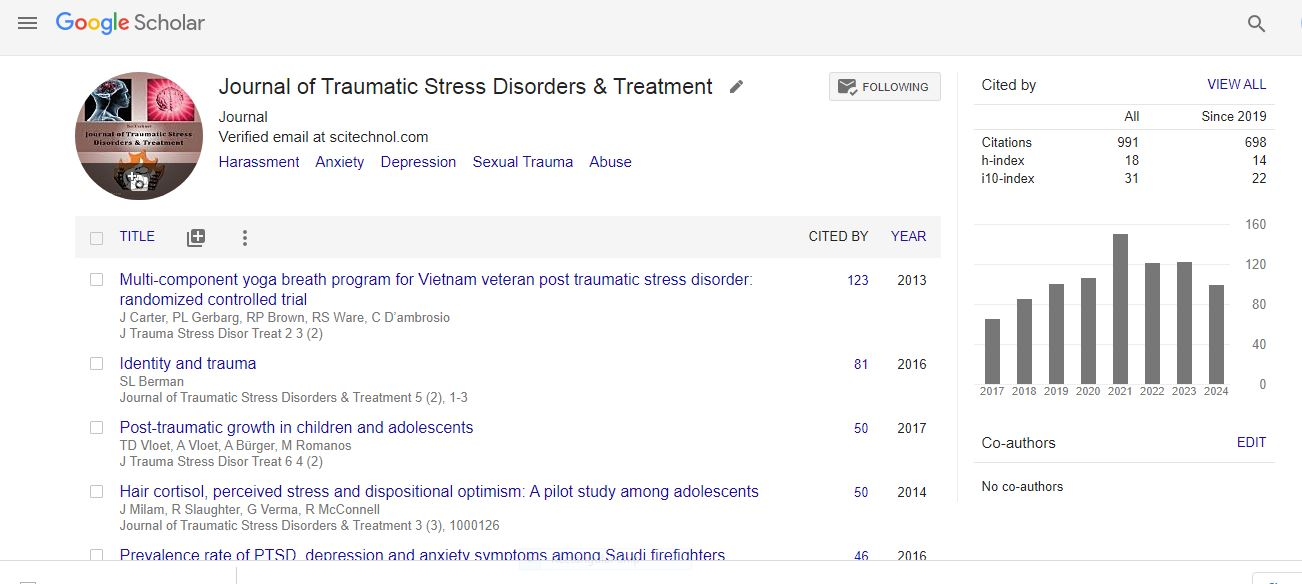Briefreport, Jtsdt Vol: 13 Issue: 5
The Biological Basis of Psychopathology: Exploring Neurochemical and Genetic Influences
Aisha Farhadi*
Department of Psychiatry, Tehran Mental Health Institute, Iran
*Corresponding Author: Aisha Farhadi
Department of Psychiatry, Tehran Mental Health Institute, Iran
E-mail: aisha.farhadi@email.com
Received: 03-Aug-2024, Manuscript No. JTSDT-24-149487;
Editor assigned: 04-Aug-2024, PreQC No. JTSDT-24-149487 (PQ);
Reviewed: 09-Aug-2024, QC No. JTSDT-24-149487;
Revised: 15-Aug-2024, Manuscript No. JTSDT-24-149487 (R);
Published: 22-Aug-2024, DOI:10.4172/2324-8947.100420
Citation: Farhadi A (2024) The Biological Basis of Psychopathology: Exploring Neurochemical and Genetic Influences. J Trauma Stress Disor Treat 13(5):417
Copyright: © 2024 Farhadi A. This is an open-access article distributed under the terms of the Creative Commons Attribution License, which permits unrestricted use, distribution and reproduction in any medium, provided the original author and source are credited.
Introduction
Psychopathology, the study of mental disorders, has long been shaped by a variety of perspectives, ranging from psychological and environmental to biological factors. Over the past few decades, there has been a surge of interest in understanding the biological basis of psychopathology. This article delves into the neurochemical and genetic underpinnings of mental disorders, providing insights into how disruptions in neurotransmitter systems and genetic vulnerabilities contribute to the development of mental illnesses [1].
One of the most significant biological factors involved in psychopathology is the neurochemical imbalance in the brain. Neurotransmitters—chemical messengers like serotonin, dopamine, and norepinephrine—play a pivotal role in regulating mood, cognition, and behavior. Disruptions in the levels or functioning of these neurotransmitters are strongly linked to several mental disorders. For example, depression is often associated with reduced serotonin levels, while schizophrenia has been linked to excessive dopamine activity [2].
Serotonin is a key neurotransmitter involved in regulating mood, emotion, and anxiety. Research shows that abnormal serotonin transmission contributes to mood disorders such as major depressive disorder (MDD) and anxiety disorders. Selective serotonin reuptake inhibitors (SSRIs), which increase serotonin availability in the brain, have become a first-line treatment for depression and anxiety, underscoring the neurochemical underpinnings of these conditions [3].
Dopamine is another critical neurotransmitter linked to the regulation of pleasure, reward, and motivation. Dysregulation of dopamine signaling has been heavily implicated in the development of schizophrenia. The dopamine hypothesis suggests that an overactivity of dopamine in certain brain regions leads to symptoms such as hallucinations and delusions. Antipsychotic medications, which block dopamine receptors, are widely used to manage schizophrenia, further supporting the neurochemical foundation of this disorder [4].
Norepinephrine, a neurotransmitter involved in the fight-or-flight response, plays a significant role in regulating anxiety and arousal. Elevated norepinephrine levels are associated with heightened stress and anxiety responses, which are characteristic of anxiety disorders such as generalized anxiety disorder (GAD) and post-traumatic stress disorder (PTSD). Medications that modulate norepinephrine transmission, such as beta-blockers, are often used to reduce anxiety symptoms, emphasizing the neurochemical basis of anxiety disorders [5].
In addition to neurochemical imbalances, genetic factors play a crucial role in the development of mental disorders. Twin, family, and adoption studies have consistently shown that certain mental disorders have a hereditary component. For example, the heritability of schizophrenia is estimated to be around 80%, while major depressive disorder and bipolar disorder also show strong genetic links. These findings highlight the influence of inherited genetic vulnerabilities on the likelihood of developing psychopathology [6].
While genetic predispositions contribute to psychopathology, environmental factors also play a critical role in shaping mental health outcomes. The concept of gene-environment interaction suggests that individuals with a genetic vulnerability to mental disorders may be more susceptible to environmental stressors, such as trauma or chronic stress. For instance, individuals with certain variants of the serotonin transporter gene (5-HTTLPR) are more likely to develop depression following exposure to stressful life events [7].
Epigenetic mechanisms, which involve changes in gene expression without altering the underlying DNA sequence, have emerged as a key area of research in psychopathology. Epigenetic modifications, such as DNA methylation and histone modification, can be influenced by environmental factors and can affect the way genes are expressed [8].
Advances in neuroimaging technologies, such as functional magnetic resonance imaging (fMRI) and positron emission tomography (PET), have provided valuable insights into the biological basis of psychopathology. These imaging techniques allow researchers to visualize brain activity and identify structural and functional abnormalities associated with mental disorders. For example, individuals with depression often exhibit reduced activity in the prefrontal cortex, a region involved in regulating mood and decision-making [9].
Understanding the biological basis of psychopathology has important implications for the development of more effective treatments. The identification of specific neurochemical imbalances and genetic risk factors can lead to personalized approaches to treatment, where interventions are tailored to an individual’s unique biological profile. For example, pharmacogenetic testing, which analyzes how an individual’s genetic makeup influences their response to medications, is being increasingly used to guide the selection of psychiatric medications, optimizing treatment outcomes and reducing side effects [10].
Conclusion
The biological basis of psychopathology is complex and multifaceted, involving both neurochemical and genetic influences. Neurotransmitter imbalances, genetic vulnerabilities, and geneenvironment interactions all contribute to the development of mental disorders. Advances in neuroimaging and molecular genetics have provided a deeper understanding of these biological mechanisms, paving the way for more effective and personalized treatments.
 Spanish
Spanish  Chinese
Chinese  Russian
Russian  German
German  French
French  Japanese
Japanese  Portuguese
Portuguese  Hindi
Hindi 
